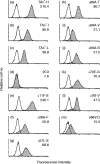A mutational analysis of the Abetaz/Aalphad major histocompatibility complex class II molecule that restricts autoreactive T cells in (NZBxNZW)F1 mice. The critical influence of alanine at position 69 in the Aalphad chain
- PMID: 10233712
- PMCID: PMC2326757
- DOI: 10.1046/j.1365-2567.1999.00706.x
A mutational analysis of the Abetaz/Aalphad major histocompatibility complex class II molecule that restricts autoreactive T cells in (NZBxNZW)F1 mice. The critical influence of alanine at position 69 in the Aalphad chain
Abstract
Autoimmune symptoms of (NZBxNZW)F1 (H-2d/z) mice are reported to be critically related to the heterozygosity at the H-2 complex of the murine major histocompatibility complex (MHC). We previously showed that several Abetaz/Aalphad MHC class II molecule-restricted autoreactive T-cell clones from B/WF1 mice were pathogenic upon transfer to preautoimmune B/WF1 mice. In this study, to identify the crucial amino acid residues in Abetaz/Aalphad molecules for T-cell activation, we generated a panel of transfectant cell lines. These transfectant cell lines express the Abetaz/Aalphad MHC molecules with a mutation at each residue alpha11, alpha28, alpha57, alpha69, alpha70, alpha76 of Aalphad chain and beta86 of Abetaz chain. Replacing alpha69 alanine with threonine, valine or serine completely eliminated the ability to stimulate autoreactive T-cell clones without affecting the ability to present foreign antigen keyhole limpet haemocyanin (KLH) or L-plastin peptide to specific T-cell clones. Replacing beta86 valine with aspartic acid resulted in a decrease in the stimulation for antigen-reactive as well as autoreactive T-cell clones. Substitutions at other residues had minimal or no effect on the stimulation of either auto- or antigen-reactive T-cell clones. These results suggest that alanine at residue 69 of the Aalphad chain is critical for the activation of autoreactive Abetaz/Aalphad-restricted T-cell clones. Possible explanations for this are discussed.
Figures




References
-
- Theofilopoulos AN, Dixon FJ. Murine models of systemic lupus erythematosus. Adv Immunol. 1985;37:269. - PubMed
-
- Shirai T, Hirose S, Okada T, Nishimura H. Immunology and immunopathology of the autoimmune disease of NZB and related mouse strains. In: Rihova B, Vetvicka V, editors. Immunological Disorders in Mice. Boca Raton: CRC Press; 1991. p. 95.
-
- Kotzin BL. Systemic lupus erythematosus. Cell. 1996;85:303. - PubMed
-
- Wofsy D, Ledbetter JA, Hendler PL, Seaman WE. Treatment of murine lupus with monoclonal anti-T cell antibody. J Immunol. 1985;134:852. - PubMed
Publication types
MeSH terms
Substances
Associated data
- Actions
- Actions
- Actions
- Actions
- Actions
- Actions
- Actions
- Actions
- Actions
- Actions
- Actions
LinkOut - more resources
Full Text Sources
Molecular Biology Databases
Research Materials

